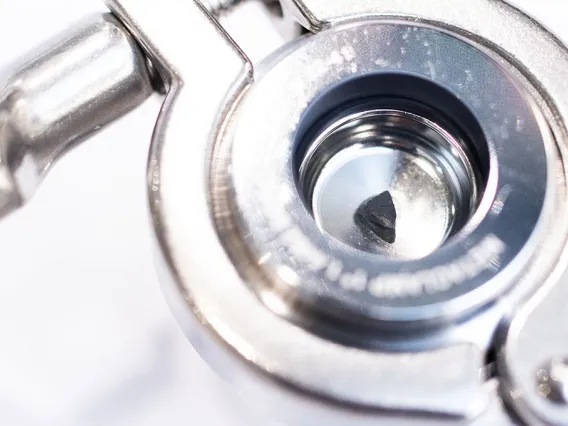
A Pebble Scooped from an Asteroid is now on Display at UArizona Museum
Tucson’s Alfie Norville Gem & Mineral Museum is one of only three places in the world where the public can see a piece of the asteroid Bennu, collected during NASA's LPL-led OSIRIS-REx mission.A Pebble Scooped from an Asteroid is now on Display at UArizona Museum
×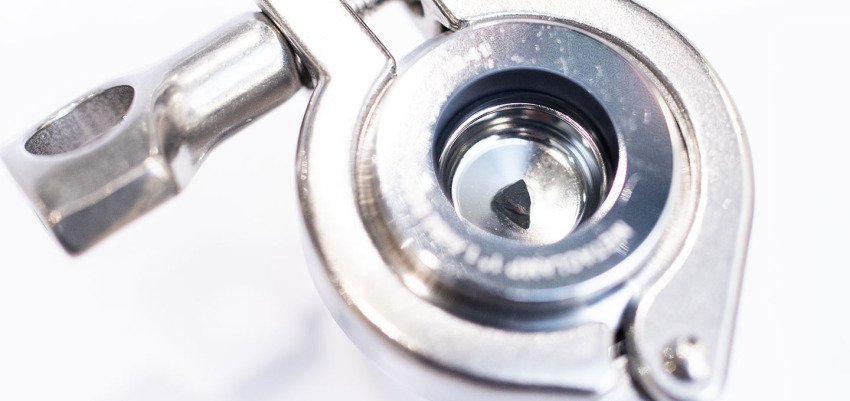
It might not be the heftiest or flashiest stone on display at the University of Arizona's Alfie Norville Gem & Mineral Museum, but it certainly is its most unique, if not downright alien: a piece from an asteroid in space, brought to Earth by NASA's UArizona-led OSIRIS-REx mission in September.
After seven years in space and over 4 billion miles traveled, it touched down in a remote area of the Utah desert, tucked safely inside a capsule protecting the sample from the harsh conditions in space and the rough ride through Earth's atmosphere.
The museum is one of only three places in the world to display an extraterrestrial rock sample collected in space, other than the moon. The other two samples from asteroid Bennu available for public viewing are at Space Center Houston in Texas and the Smithsonian National Museum of Natural History in Washington, D.C. Sample curation specialists at NASA's Johnson Space Center in Houston carefully selected the specimen suitable for public display, and visitors can check it out as of today.
Canister open.jpeg
 The spacecraft's sample canister with the lid open, inside a glovebox at NASA's Johnson Space Center in Houston. In all, OSIRIS-REx brought 121.6 grams (4.29 ounces) of material to Earth on Sept. 24. NASA/Johnson Space Center
The spacecraft's sample canister with the lid open, inside a glovebox at NASA's Johnson Space Center in Houston. In all, OSIRIS-REx brought 121.6 grams (4.29 ounces) of material to Earth on Sept. 24. NASA/Johnson Space Center"What's so special about the Bennu sample is that it was collected directly at the asteroid, in space, and that's something that we really try to help our visitors understand," said the museum's director, Violetta Wolf, explaining that while many are familiar with seeing meteorites on display, it is important to realize that those are very different.
While meteorites come from space, too, by the time they reach the ground, they have been in contact with all sorts of Earthly influences – during their fall, they are exposed to extreme heat, altering their appearance as well as possibly their structure and chemical makeup. Then they smack into the ground, sometimes digging into the soil. By the time they are found and collected, they have been exposed to the air, water, microbes and who knows what.
"To have something that actually has never been in contact with our atmosphere or anything else on our planet, is exceptional and incredibly rare," Wolf said. "We only have two pieces in the museum like that, and that's the lunar sample and now the sample from Bennu."
In all, OSIRIS-REx brought 121.6 grams (4.29 ounces) of material to Earth on Sept. 24. Of that amount, UArizona scientists received 200 milligrams (approximately 7 thousandths of an ounce) of asteroid material for scientific study. Initial analyses indicate the samples contain plentiful amounts of water locked up in minerals like clays and are also rich in carbon, nitrogen, sulfur and phosphorus.
Bigger than the sand-size science samples that are currently being analyzed at the university, the specimen that NASA allocated for public display in Tucson is a small, dark pebble with well-defined structure and texture. It will go on display next to a moon rock brought to Earth by astronauts of the Apollo 15 mission.
"It's not huge, of course, but for a sample of this significance, it's actually pretty large," Wolf said, adding that the roughly pinky-nail-size display specimen is actually larger than expected.
"You can actually see it's a small pebble, very dark, almost black," she said. "It almost seems like something that you would shake out your shoe after a long hike. If you look closely, you can see some different textures in it, some different colors."
Educational samples are specifically portioned out to recognize the importance of not just the scientific research, but the potential to inspire and encourage future scientists, Wolf said.
The specimen is tucked inside a clear container held by a metal casing to protect it from mechanical damage. A protective nitrogen atmosphere protects it from being exposure to air and prevents chemical alteration.
"NASA's approach to scientific research is that it has to also benefit the public through interpretation and getting young people excited about careers in science and space-related research and technology," Wolf said. "Putting it in its display case really was a humbling moment – recognizing what just passed through our hands."
And while that small piece of asteroid Bennu will sit in its case, shielded from Earth's ever-changing environment, its story has only just begun. As OSIRIS-REx scientists are beginning to probe the stuff left over from the formation of the solar system about 4.6 billion years ago, they will make countless discoveries, and with each one, a little bit more will be known about the display sample.
"This is not a 'one and done' kind of exhibit," Wolf said. "We're going to keep adding more information as we learn. Having this on display is a huge milestone, but there's still so much to come."
As new analytic technologies become available and new papers are being published, researchers such as Dante Lauretta, the mission's principal investigator at the UArizona Lunar and Planetary Laboratory, will share those insights with the public, and Wolf and her team already look forward to updating the information on the display to share them with the public.
"Having this asteroid sample on display is a testament to the incredible achievements of the OSIRIS-REx mission and the dedication of the team behind it," Lauretta said. "It's a tangible reminder of humanity's ability to explore the cosmos and unravel the mysteries of our universe."
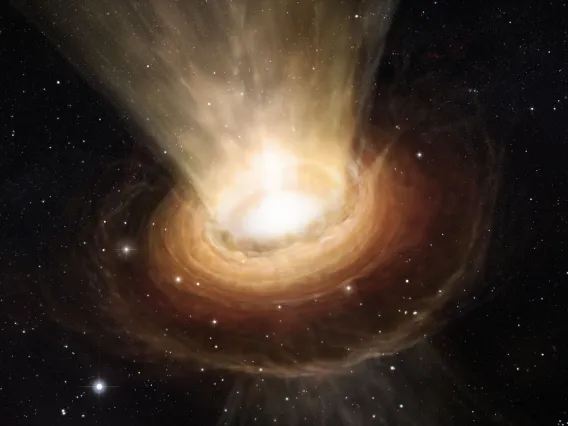
James Webb Space Telescope Captures the End of Planet Formation
We know that there is nearly 100 times more gas than solids present when planets form. But today we see only a fraction of that gas in the solar system (stored within gas giant planets like Jupiter). So, when and how did the remaining gas leave the system? New research featuring LPL graduate student Naman Bajaj as lead author seeks to answer this exact question.James Webb Space Telescope Captures the End of Planet Formation
×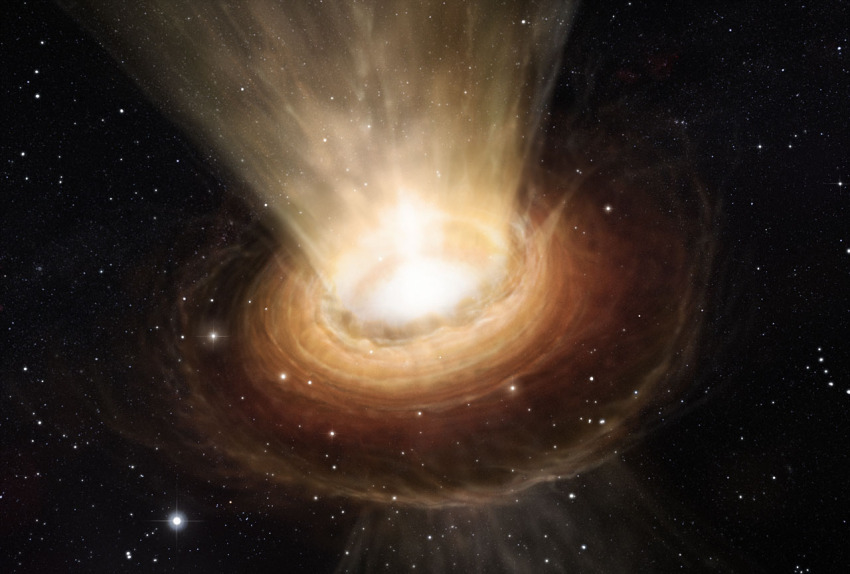
Scientists believe that planetary systems like our solar system contain more rocky objects than gas-rich ones. Around our sun, these include the inner planets – Mercury, Venus, Earth and Mars – the asteroid belt and the Kuiper belt objects such as Pluto.
Jupiter, Saturn, Uranus and Neptune, on the other hand, contain mostly gas. But scientists also have known for a long time that planet-forming disks start out with 100 times more mass in gas than solids, which leads to a pressing question: When and how does most of the gas leave a nascent planetary system?
A new study led by Naman Bajaj at the University of Arizona Lunar and Planetary Laboratory, published in the Astronomical Journal, provides answers. Using the James Webb Space Telescope, or JWST, the team obtained images from such a nascent planetary system – also known as a circumstellar disk – in the process of actively dispersing its gas into surrounding space.
"Knowing when the gas disperses is important as it gives us a better idea of how much time gaseous planets have to consume the gas from their surroundings," said Bajaj, a second-year doctoral student at UArizona's Lunar and Planetary Laboratory. "With unprecedented glimpses into these disks surrounding young stars, the birthplaces of planets, JWST helps us uncover how planets form."
During the very early stages of planetary system formation, planets coalesce in a spinning disk of gas and tiny dust around the young star, according to Bajaj. These particles clump together, building up into bigger and bigger chunks called planetesimals. Over time, these planetesimals collide and stick together, eventually forming planets. The type, size and location of planets that form depend on the amount of material available and how long it remains in the disk.
"So, in short, the outcome of planet formation depends on the evolution and dispersal of the disk," Bajaj said.
At the heart of this discovery is the observation of T Cha, a young star – relative to the sun, which is about 4.6 billion years old – enveloped by an eroding circumstellar disk notable for a vast dust gap, spanning approximately 30 astronomical units, or au, with one au being the average distance between the Earth and the sun.
Bajaj and his team were able, for the first time, to image the disk wind, as the gas is referred to when it slowly leaves the planet-forming disk. The astronomers took advantage of the telescope's sensitivity to light emitted by an atom when high-energy radiation – for example, in starlight – strips one or more electrons from its nucleus. This is known as ionization, and the light emitted in the process can be used as a sort of chemical "fingerprint" – in the case of the T Cha system, tracing two noble gases, neon and argon. The observations also mark the first time a double ionization of argon has been detected in a planet-forming disk, the team writes in the paper.
"The neon signature in our images tells us that the disk wind is coming from an extended region away from the disk," Bajaj said. "These winds could be driven either by high-energy photons – essentially the light streaming from the star – or by the magnetic field that weaves through the planet-forming disk."
In an effort to differentiate between the two, the same group, this time led by Andrew Sellek, a postdoctoral researcher at Leiden University in the Netherlands, performed simulations of the dispersal driven by stellar photons, the intense light streaming from the young star. They compared these simulations to the actual observations and found dispersal by high-energy stellar photons can explain the observations, and hence cannot be excluded as a possibility. That study concluded that the amount of gas dispersing from the T Cha disk every year is equivalent to that of Earth's moon. These results will be published in a companion paper, currently under review with the Astronomical Journal.
While neon signatures had been detected in many other astronomical objects, they weren't known to originate in low-mass planet-forming disks until first discovered in 2007 with JWST's predecessor, NASA's Spitzer Space Telescope, by Ilaria Pascucci, a professor at LPL who soon identified them as a tracer of disk winds. Those early findings transformed research efforts focused on understanding gas dispersal from circumstellar disks. Pascucci is the principal investigator on the most recent observing project and a co-author on the publications reported here.
"Our discovery of spatially resolved neon emission – and the first detection of double ionized argon – using the James Webb Space Telescope could become the next step towards transforming our understanding of how gas clears out of a planet-forming disk," Pascucci said. "These insights will help us get a better idea of the history and impact on our own solar system."
In addition, the group has also discovered that the inner disk of T Cha is evolving on very short timescales of decades; they found that the spectrum observed by JWST differs from the earlier spectrum detected by Spitzer. According to Chengyan Xie, a second-year doctoral student at LPL who leads this in-progress work, this mismatch could be explained by a small, asymmetric disk inside of T Cha that has lost some of its mass in the short 17 years that have elapsed between the two observations.
"Along with the other studies, this also hints that the disk of T Cha is at the end of its evolution," Xie said. "We might be able to witness the dispersal of all the dust mass in T Cha's inner disk within our lifetime."
Co-authors on the publications include Uma Gorti with the SETI Institute, Richard Alexander with the University of Leicester, Jane Morrison and Andras Gaspar with the UArizona's Steward Observatory, Cathie Clarke with the University of Cambridge, Giulia Ballabio with Imperial College London, and Dingshan Deng with the Lunar and Planetary Laboratory.
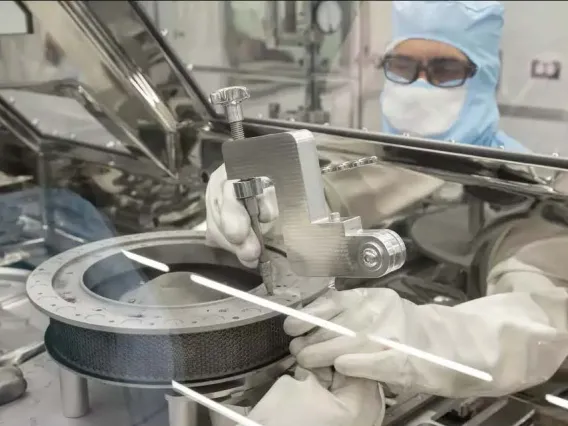
NASA's OSIRIS-REx Curation Team Clears Hurdle to Access Remaining Bennu Sample
Before this milestone, the curation team already had collected more than the 60 grams required to declare the mission a success.NASA's OSIRIS-REx Curation Team Clears Hurdle to Access Remaining Bennu Sample
×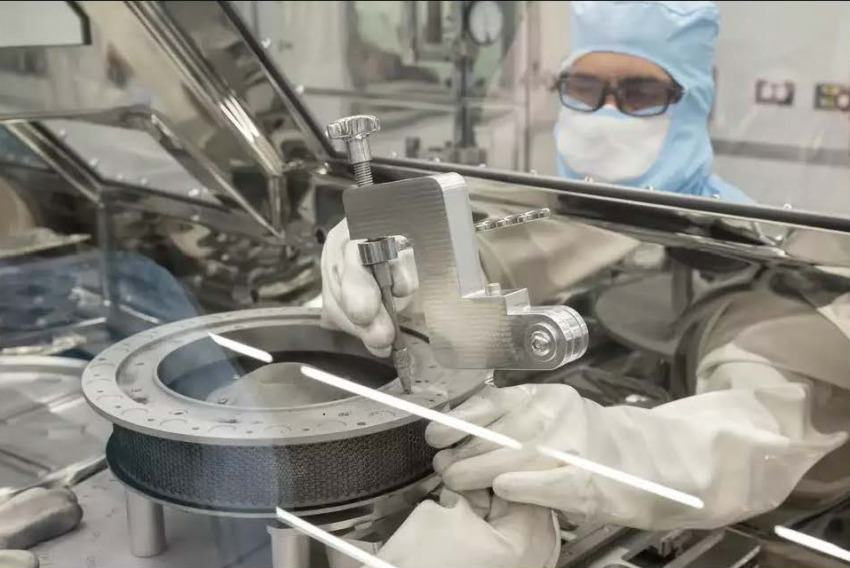
NASA Johnson Space Center and University Communications - January 11, 2024
NASA's Johnson Space Center curation team members have successfully removed the two fasteners from the sampler head that had prevented the remainder of OSIRIS-REx's asteroid Bennu sample material from being accessed.
Steps now are underway to complete the disassembly of the Touch-and-Go Sample Acquisition Mechanism, or TAGSAM, head to reveal the rest of the rocks and dust delivered by NASA's first asteroid sample return mission. The mission, which launched in 2016 and spent the next seven years traveling to Bennu and imaging the asteroid before collecting the sample, returned the sample to Earth on Sept. 24.
The sample is thought to contain the leftovers from the formation of the solar system 4.5 billion years ago.
"Finally having the TAGSAM head open and full access to the returned Bennu samples is a monumental achievement that reflects the unwavering dedication and ingenuity of our team," said the mission's principal investigator, Dante Lauretta, Regents Professor at the University of Arizona Lunar and Planetary Laboratory. "This success reaffirms the significance of OSIRIS-REx and our commitment to advancing our understanding of the cosmos. We eagerly anticipate the next chapter as we share these precious samples with the global scientific community and continue our journey of discovery."
The remainder of the bulk sample will be fully visible after a few additional disassembly steps, at which point image specialists will take ultra-high-resolution pictures of the sample while it is still inside the TAGSAM head. This portion of the sample will then be removed and weighed, and the team will be able to determine the total mass of Bennu material captured by the mission.
"Our engineers and scientists have worked tirelessly behind the scenes for months to not only process the more than 70 grams of material we were able to access previously, but also design, develop and test new tools that allowed us to move past this hurdle," said Eileen Stansbery, division chief for Astromaterials Research and Exploration Science at Johnson. "The innovation and dedication of this team has been remarkable. We are all excited to see the remaining treasure OSIRIS-REx holds."
Curation processors paused disassembly of the TAGSAM head hardware in mid-October after they discovered that two of the 35 fasteners could not be removed with the tools approved for use inside the OSIRIS-REx glovebox. In response, two new multi-part tools were designed and fabricated to support further disassembly of the TAGSAM head. These tools include newly custom-fabricated bits made from a specific grade of surgical, non-magnetic stainless steel – the hardest metal approved for use in the pristine curation gloveboxes.
"In addition to the design challenge of being limited to curation-approved materials to protect the scientific value of the asteroid sample, these new tools also needed to function within the tightly confined space of the glovebox, limiting their height, weight and potential arc movement," said Nicole Lunning, OSIRIS-REx curator at Johnson. "The curation team showed impressive resilience and did incredible work to get these stubborn fasteners off the TAGSAM head so we can continue disassembly. We are overjoyed with the success."
Prior to the successful removal, the team at Johnson tested the new tools and removal procedures in a rehearsal lab. After each successful test, engineers increased the assembly torque values – or twisting force – and repeated the testing procedures until the team was confident the new tools would be able to remove the fasteners while minimizing the risk of any potential damage to the TAGSAM head or any contamination of the sample within.
Despite not being able to fully disassemble the TAGSAM head, the curation team members had already collected 2.48 ounces, or 70.3 grams, of asteroid material from the sample hardware, surpassing the agency's goal of bringing at least 60 grams to Earth. They have fulfilled all the sample requests received from the OSIRIS-REx science team so far and have hermetically sealed some of the Bennu sample for better preservation over decades, storing some at ambient temperature conditions and others at minus-112 degrees Fahrenheit.
Meanwhile, scientists at UArizona's Kuiper-Arizona Laboratory for Astromaterials Analysis have begun analyzing some of the pristine extraterrestrial material that the mission delivered from Bennu.
Later this spring, the curation team will release a catalog of the OSIRIS-REx samples, which will be available to the global scientific community.
UA News - NASA's OSIRIS-REx Curation Team Clears Hurdle to Access Remaining Bennu Sample

UArizona-led Asteroid Sampling Mission's New Journey: OSIRIS-APEX
Under the leadership of the University of Arizona's Dani Mendoza DellaGiustina, the former OSIRIS-REx spacecraft sets off on a journey to study asteroid Apophis and take advantage of the asteroid's 2029 flyby of Earth.UArizona-led Asteroid Sampling Mission's New Journey: OSIRIS-APEX
×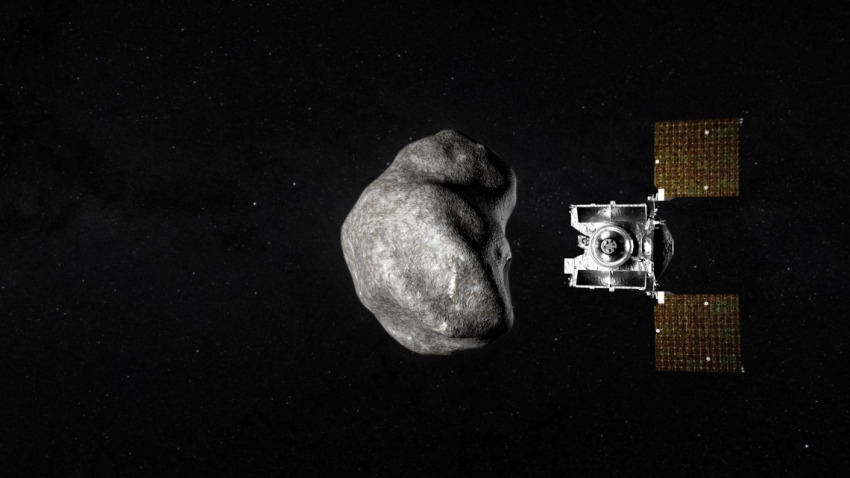
By University Communications and NASA Goddard Space Flight Center - January 8, 2024
At the end of a long-haul road trip, it might be time to kick up your feet and rest awhile – especially if it was a seven-year, 4-billion-mile journey to bring Earth a sample of asteroid Bennu.
But OSIRIS-REx, the NASA mission that accomplished this feat in September, is already well on its way – with a new name – to explore a new destination, this time under the leadership of Dani Mendoza DellaGiustina, an assistant professor at the University of Arizona's Lunar and Planetary Laboratory who previously served as the deputy principal investigator of OSIRIS-REx.
When OSIRIS-REx left Bennu in May 2021 with a sample aboard, its instruments were in great condition, and it still had a quarter of its fuel left. So instead of shutting down the spacecraft after it delivered the sample, the team proposed to dispatch it on a bonus mission to asteroid Apophis, with an expected arrival in April 2029. NASA agreed, and OSIRIS-APEX (Origins, Spectral Interpretation, Resource Identification, and Security – Apophis Explorer) was born.
A rare opportunity at Apophis
After considering several destinations, including Venus and various comets, NASA chose to send the spacecraft to Apophis, an "S-type" asteroid made of silicate materials and nickel-iron – a fair bit different from the carbon-rich, "C-type" Bennu.
The intrigue of Apophis is its exceptionally close approach of our planet on April 13, 2029. Although Apophis will not hit Earth during this encounter or in the foreseeable future, the pass in 2029 will bring the asteroid within 20,000 miles (32,000 kilometers) of the surface – closer than some satellites, and close enough that it could be visible to the naked eye in the Eastern Hemisphere.
Apophis' close encounter with Earth will change the asteroid’s orbit and the length of its 30.6-hour day. The encounter also may cause quakes and landslides on the asteroid's surface that could churn up material and uncover what lies beneath.
"The close approach is a great natural experiment," DellaGiustina said. "We know that tidal forces and the accumulation of rubble pile material are foundational processes that could play a role in planet formation. They could inform how we got from debris in the early solar system to full-blown planets."
 OSIRIS-APEX mission principal investigator Dani DellaGiustina.Chris Richards/University Communications
OSIRIS-APEX mission principal investigator Dani DellaGiustina.Chris Richards/University Communications
Scientists estimate that asteroids of Apophis' size, about 367 yards (or 340 meters) across, come this close to Earth only once every 7,500 years.
"OSIRIS-APEX will study Apophis immediately after such a pass, allowing us to see how its surface changes by interacting with Earth's gravity," said Amy Simon, the mission's project scientist based at NASA's Goddard Space Flight Center in Greenbelt, Maryland.
Apophis represents more than just the opportunity to learn more about how solar systems and planets form: As it happens, most of the known potentially hazardous asteroids – those whose orbits come within 4.6 million miles of Earth – are also S-types. What the team learns about Apophis can inform planetary defense research, a top priority for NASA.
OSIRIS-APEX: Travel itinerary
By April 2, 2029 – around two weeks before Apophis' close encounter with Earth – OSIRIS-APEX's cameras will begin taking images of the asteroid as the spacecraft catches up to it. Apophis will also be closely observed by Earth-based telescopes during this time. But in the hours after the close encounter, Apophis will appear too near the sun in the sky to be observed by ground-based optical telescopes. This means any changes triggered by the close encounter will be best detected by the spacecraft.
OSIRIS-APEX will arrive at the asteroid later in April 2029, and operate in its proximity for about the next 18 months. In addition to studying changes to Apophis caused by its Earth encounter, the spacecraft will conduct many of the same investigations OSIRIS-REx did at Bennu, including using its instrument suite of imagers, spectrometers and a laser altimeter to closely map the surface and analyze its chemical makeup.
As an encore, OSIRIS-APEX will reprise one of OSIRIS-REx's most impressive acts (minus sample collection), dipping within 16 feet of the asteroid's surface and firing its thrusters downward. This maneuver will stir up surface rocks and dust to give scientists a peek at the material that lies below.
Dante Lauretta, principal investigator of the OSIRIS-REx mission, said he is excited about the extended mission as it holds the promise of uncovering new insights into the solar system's formation and planetary defense.
"As we transition from OSIRIS-REx to OSIRIS-APEX, I'm proud to pass the torch to Dani DellaGiustina and the extended mission team," he said. "OSIRIS-APEX carries the legacy of OSIRIS-REx, and I'm eager to see the discoveries it will make. This mission embodies our relentless pursuit of knowledge and the spirit of exploration."
Although the rendezvous with Apophis is more than five years away, the next milestone on its journey is the first of six close sun passes. Those near approaches, along with three gravity assists from Earth, will put OSIRIS-APEX on course to reach Apophis in April 2029.
UArizona-led Asteroid Sampling Mission's New Journey: OSIRIS-APEX - UA News

Sweating The Small Stuff: UArizona Scientists Have Begun To Study Samples From Asteroid Bennu
At the university's Kuiper-Arizona Laboratory for Astromaterials Analysis (K-ALFAA), a suite of instruments allows researchers to study the particles collected by the OSIRIS-REx mission the down to the atomic scale.Sweating The Small Stuff: UArizona Scientists Have Begun To Study Samples From Asteroid Bennu
×
By Daniel Stolte, University Communications - December 20, 2023
Lately, Tom Zega has been watching his caffeine intake before heading to work.
As a co-investigator of NASA's OSIRIS-REx sample analysis team, Zega is one of a small, but growing, number of scientists who have begun to work on analyzing the pristine extraterrestrial material that the University of Arizona-led mission brought back from Bennu, a near-Earth asteroid thought to be a leftover from the formation of the solar system 4.5 billion years ago.
 University of Arizona scientists have received 200 milligrams – roughly seven-thousandths of an ounce – of the asteroid Bennu sample for analysis. The small particles pictured here in a concavity slide are observed under an optical microscope. Chris Richards/University Communications
University of Arizona scientists have received 200 milligrams – roughly seven-thousandths of an ounce – of the asteroid Bennu sample for analysis. The small particles pictured here in a concavity slide are observed under an optical microscope. Chris Richards/University Communications
Some particles in the Bennu sample are tiny, barely visible with the unaided eye, and manipulating them requires a very steady hand, said Zega, a professor of planetary science at the UArizona Lunar and Planetary Laboratory.
"I sometimes joke with my students about this – if you've had not enough caffeine or too much, your hand might be somewhat shaky, and the smaller the particle you're working with, the more careful you obviously have to be," he said. Currently, his team at LPL has been allocated about 200 milligrams of sample from Bennu – roughly seven-thousandths of an ounce.
Thanks to the extremely sophisticated equipment at UArizona's Kuiper-Arizona Laboratory for Astromaterials Analysis, they can extract a wealth of information from sample particles down to the nanogram, even picogram level, referring to a billionth or trillionth of a gram, respectively.
The team's main interest lies in how these materials found on the asteroid came to be, and what clues they hold for the origin of the planets, including Earth. A quarter of the sample, which is being curated at NASA's Johnson Space Center in Houston, may be allocated to the members of the mission’s science team, who are spread across the world, while about 70% will be preserved for researchers outside the mission team and for future generations, much like was done with the rocks and soil brought back by the astronauts of the Apollo moon landings, according to Zega.
"NASA preserved a large fraction of those samples for subsequent generations of scientists to look at, and we're still doing groundbreaking science on lunar samples that were brought back in the late 1960s and early 1970s," he said. "Just like the instruments we have now surpass the instruments that they had available at that time, in the future, we'll have instruments that surpass those that we have now."
 University of Arizona scientists have received a small portion of the asteroid Bennu sample and analysis has begun in their lab. Here, doctoral student Lucas Smith loads Bennu sample into an electron microscope for analysis. Chris Richards/University Communications
University of Arizona scientists have received a small portion of the asteroid Bennu sample and analysis has begun in their lab. Here, doctoral student Lucas Smith loads Bennu sample into an electron microscope for analysis. Chris Richards/University Communications
What makes these samples unique and precious is that they were collected at the place they originated, unlike meteorites, which don't make it into the lab until after a long journey to Earth's surface. Meteorites are no longer pristine because they have been exposed to heat during their fall through the atmosphere and weathering on the ground, and they could come from anywhere. They lack, as geologists say, "context."
"With these samples from Bennu, we now have all the contextual information that will enable us to study these materials at the fundamental levels and tell the story of the origins and history of asteroid Bennu," Zega said.
A suite of instruments at the LPL's lab, ranging from optical to electron microscopes allows the team to probe the sample down to the atomic scale, according to Pierre Haenecour, assistant professor of planetary science at LPL and OSIRIS-REx co-investigator.
"We literally can look at single atoms," he said. "We also have a nanoscale secondary ion mass spectrometer, or nanoSIMS for short. It allows us to look at isotopes (different variations of atoms) to understand how each particular component in the sample originated."
Early findings confirm the predictions made about Bennu from the remote survey the OSIRIS-REx spacecraft performed during two years at the asteroid, prior to going in for the sample grab.
As suggested by remote observation of the asteroid, Bennu samples contain copious amounts of water locked up in minerals like clays. The samples are also rich in carbon, nitrogen, sulfur, and phosphorous, according to LPL assistant professor Jessica Barnes, who also is an OSIRIS-REx co-investigator.
"The abundance and isotopic composition of these and other elements will allow us to investigate where in the solar system Bennu’s parent body formed and from which constituents," she said. "The study of organic molecules may help us unravel the chemical processes that turned these simple elements into complex molecules that may have helped start life on Earth and possibly elsewhere."
Training students in cutting-edge science is an important part of the OSIRIS-REx mission. The opportunity to come to the university as a graduate student and spend four or five years working on a sample from a mission as historic as OSIRIS-REx is one that Haenecour said he would have loved.
"It really is a historic opportunity to get involved in and get to do some groundbreaking science," he said.
 Discussing sample analysis measurements in the lab: doctoral students Zoë Wilbur, Lucas Smith and Iunn Ong (front to back). Chris Richards/University Communications
Discussing sample analysis measurements in the lab: doctoral students Zoë Wilbur, Lucas Smith and Iunn Ong (front to back). Chris Richards/University Communications
Working with samples of such significance comes with a responsibility that everyone takes seriously, Zega said. Getting everything right is important, and much work goes into the actual measurement itself – calibrating the instruments, taking meticulous notes and laying out the entire thought process before beginning the experiments. Some of the analytical techniques consume sample material in the process, and everyone on the sample analysis team is conscious of that, Zega said.
"I'd be lying if I said I didn't feel pressure when I'm working with one of these samples," he said, adding that when he is working in the lab, he tends to not want an audience. "Sometimes, when I have a collaborator in the lab, and we are working together, I tell them, 'I need you to not talk for the next few minutes, because we're in a really critical step here.'"
Per NASA's science requirement, the OSIRIS-REx mission was tasked with bringing 60 grams, or about two ounces, of sample to Earth. With a confirmed sample mass so far of just over 70 grams, and more sample still waiting to be extracted from the sampling head, the mission has already achieved this milestone, Zega said.
"It is very exciting to have samples from Bennu inside our labs, in the same building where the mission was first conceived by the late LPL Director Mike Drake," said Mark Marley, head of the Department of Planetary Sciences and director of LPL. "I am so proud of our faculty, staff and students who have carried his vision to completion."
The sample analysis team comprises about 200 researchers from all over the world, who coordinate the types of measurements and analyses to ensure that they maximize the science they get from the sample. Hundreds of scientific papers describing analyses of the Bennu sample are expected just in the next couple of years.
According to Haenecour, one 10-microgram particle is enough to produce science for years at a time, and the amount of sample already at UArizona is enough to keep students busy for years.
UArizona's Dante Lauretta is the principal investigator for OSIRIS-REx (formally the Origins, Spectral Interpretation, Resource Identification and Security – Regolith Explorer), and he leads the science team and the mission’s science observation planning and data processing. NASA's Goddard Space Flight Center in Greenbelt, Maryland, provides overall mission management. Lockheed Martin Space in Littleton, Colorado, built the spacecraft. Goddard and KinetX Aerospace were responsible for navigating the OSIRIS-REx spacecraft.
Sweating The Small Stuff: UArizona Scientists Have Begun To Study Samples From Asteroid Bennu - UA News
OSIRIS-REx Sample Analysis Begins at the University of Arizona - YouTube Video

Recent Volcanism on Mars Reveals a Planet More Active than Previously Thought
University of Arizona researchers reconstructed lava flows from spacecraft images and radar to better understand Mars' surprisingly turbulent history.Recent Volcanism on Mars Reveals a Planet More Active than Previously Thought
×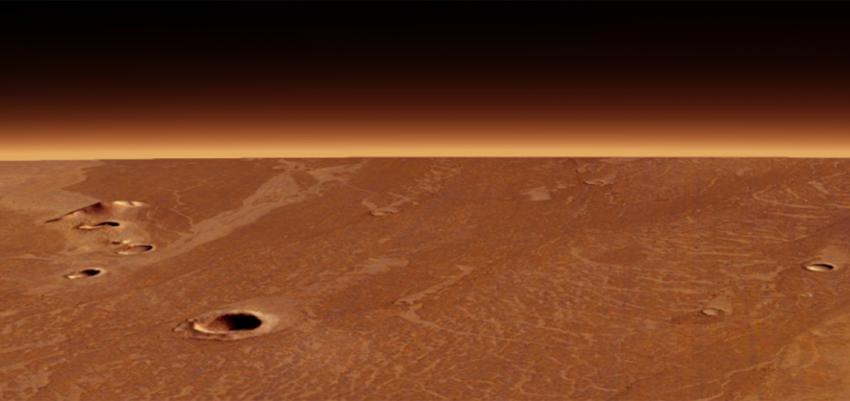
By Daniel Stolte, University Communications - December 18, 2023
A vast, flat, "featureless" plain on Mars surprised researchers by revealing a much more tumultuous geologic past than expected, according to a study led by researchers at the University of Arizona. Enormous amounts of lava have erupted from numerous fissures as recently as one million years ago, blanketing an area almost as large as Alaska and interacting with water in and under the surface, resulting in large flood events that carved out deep channels.
Lacking plate tectonics – shifting chunks of crust that constantly reshape Earth's surface – Mars has long been thought to be a geologically "dead" planet where not much is happening. Recent discoveries have researchers questioning this notion, however. Just last year, a team of planetary scientists, also at UArizona, presented evidence for a giant mantle plume underneath the region Elysium Planitia, driving intense volcanic and seismic activity in a relatively recent past.
In the most recent study, a team led by Joana Voigt and Christopher Hamilton at UArizona's Lunar and Planetary Laboratory combined spacecraft images and measurements from ground-penetrating radar to reconstruct in three-dimensional detail every individual lava flow in Elysium Planitia. The extensive survey revealed and documented more than 40 volcanic events, with one of the largest flows infilling a valley named Athabasca Valles with almost 1,000 cubic miles of basalt.
"Elysium Planitia is the youngest volcanic terrain on the planet, and studying it helps us to better understand Mars' past as well as recent hydrological and volcanic history," the authors write in their paper. Although no volcanic activity has so far been observed on Mars, "Elysium Planitia was volcanically much more active than previously thought and might even still be volcanically alive today," said Voigt, the first author of the study, published in the Journal of Geophysical Research: Planets. A plethora of Mars quakes recorded by NASA's InSight lander between 2018 until 2022 has provided proof that beneath its surface, the red planet is anything but dead.
 The fractures of the Cerberus Fossae landscape, located in the vast plain Elysium Planitia on Mars, cut through hills and craters, indicating their relative youth. A new study providing the most detailed three-dimensional map of volcanic features in this area paints a picture of Mars as planet with a much more tumultuous geologic past than previously thought. ESA/DLR/FU Berlin
The fractures of the Cerberus Fossae landscape, located in the vast plain Elysium Planitia on Mars, cut through hills and craters, indicating their relative youth. A new study providing the most detailed three-dimensional map of volcanic features in this area paints a picture of Mars as planet with a much more tumultuous geologic past than previously thought. ESA/DLR/FU Berlin
"Our study provides the most comprehensive account of geologically recent volcanism on a planet other than Earth," said Hamilton, associate professor at LPL. "It is the best estimate of Mars' young volcanic activity for about the past 120 million years, which corresponds to when the dinosaurs roaming the Earth at their peak to present."
The findings have implications for research surrounding whether Mars could have harbored life at some point in its history, according to the authors. Elysium Planitia experienced several large floods of water, and there is evidence that the outpouring lava interacted with water or ice, shaping the landscape in dramatic ways. Across Elysium Planitia, Voigt and her co-authors found ample evidence of steam explosions, interactions that are of great interest to astrobiologists because they may have created hydrothermal environments conducive to microbial life.
The team used images from the Context camera onboard NASA's Reconnaissance Orbiter, or MRO, combined with even higher-resolution images from MRO's UArizona-led HiRISE camera in selected areas. To obtain topographical information, they took advantage of data records from the Mars Orbiter Laser Altimeter on another NASA spacecraft, Mars Global Surveyor. These survey data were then combined with subsurface radar measurements taken with NASA's Shallow Radar, or SHARAD, probe.
"With SHARAD, we were able to look as deep as 140 meters (460 feet) below the surface," said Voigt, who completed the study as part of earning her doctoral degree at UArizona. She is now a postdoctoral researcher at Caltech's Jet Propulsion Laboratory, or JPL, in Pasadena, California.
"Combining the datasets allowed us to reconstruct a three-dimensional view of the study area, including what the topography was like before lava erupted from multiple cracks and filled basins and channels previously carved by running water, Voigt added."
Mars' interior is thought to be very different from Earth's, and a detailed reconstruction of its geological features provides scientists with glimpses into the processes that shaped it in the past. The relationship between volcanoes and the structure of the Martian crust is key to understanding the planet's paleo-environmental conditions, Hamilton said. In addition to water contained within the magma being flung into the atmosphere and then freezing out on the surface, a volcanic eruption can allow for a catastrophic groundwater release onto the surface.
"When there is a crack in the Martian crust, water can flow onto the surface," Hamilton said. "Because of the low atmospheric pressure, that water is likely to literally just boil away. But if there's enough water coming out during that period, you can get a huge flood that comes through, racing over the landscape and carving out these huge features that we see."
Understanding how water has moved around on Mars in the past and where it is today is a "holy grail" question, the authors said. Because the equatorial regions, where Elysium Planitia is located, are much easier to land on than the planet's higher latitudes, the presence of water and understanding mechanisms of its release inform future human missions, which will critically depend on that resource.
"Elysium Planitia is the perfect location to try to understand the link between what we see at the surface and the interior dynamics that manifested itself through volcanic eruptions," Voigt said. "I paid a lot of attention to the details on the lava surfaces to try and untangle the different eruption events and reconstruct the entire history of these geologic entities."
The team plans to continue taking advantage of large, complex datasets obtained with different imaging methods to create highly detailed, three-dimensional insights of the Martian surface and what lies beneath, combined with a time sequence of events of other volcanically active regions.
Voigt likened lava flow surfaces to "open books that provide a wealth of information about how they came to be if you know how to read them."
"These areas that used to be considered featureless and boring, like Elysium Planitia, I think they contain a lot of secrets, and they want to be read," she said.
The work was supported by a NASA Future Investigators in NASA Earth and Space Science and Technology grant. Co-authors on the paper are Gregor Steinbrügge and Laura Kerber at JPL, S. Nerozzi, Jack Holt and Lynn Carter at UArizona's LPL, and Michael Christofferson at the University of Alaska Fairbanks.
Recent Volcanism on Mars Reveals a Planet More Active than Previously Thought
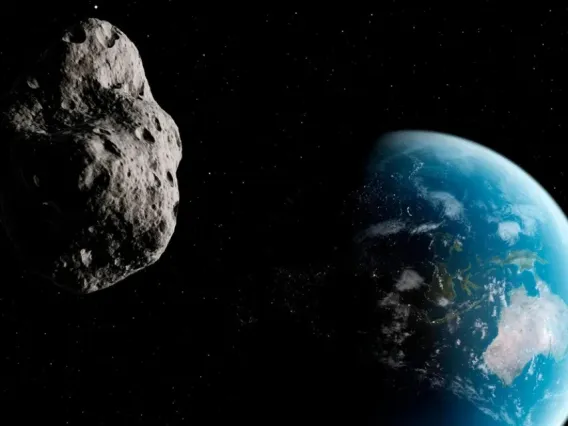
Citizen Science Project Nets a New Asteroid, and It's a Close One
Members of the public helped the University of Arizona's Catalina Sky Survey spot a previously unknown near-Earth asteroid on its orbit around the sun. The asteroid, TW 2023, has no chance of colliding with Earth.Citizen Science Project Nets a New Asteroid, and It's a Close One
×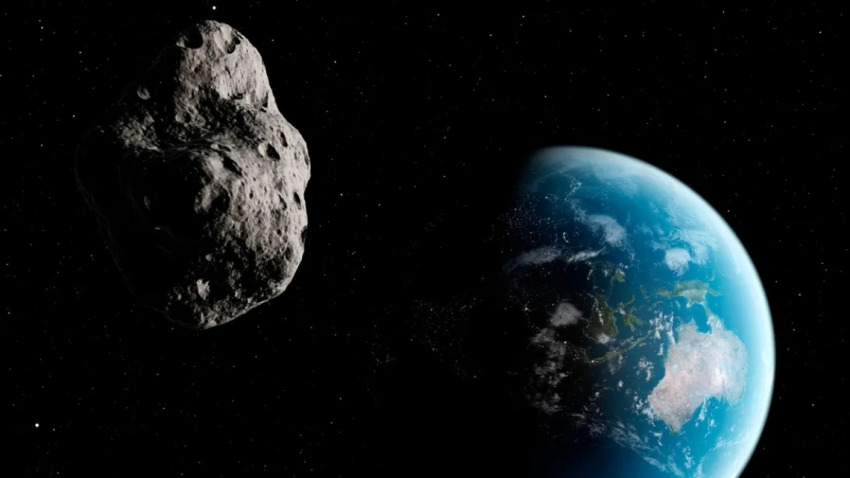
By Penny Duran, NASA Space Grant Science Writing Intern - December 6, 2023
Discovering asteroids in space used to be a privilege reserved for astronomers – until now, thanks to a project led by the University of Arizona Catalina Sky Survey, which made it possible for several members of the public to spot a previously unknown near-Earth asteroid on its orbit around the sun.
Named 2023 TW, the newly discovered asteroid is the closest to ever be discovered by a citizen science initiative, according to Catalina Sky Survey researchers. Initial calculations indicate it ventures into Earth's vicinity at a "mean orbital intercept distance" of 375,000 miles, about 35,000 miles past the average distance between the Earth and the moon.
"The mean orbital intercept distance describes how close an object approaches Earth's orbit," said Carson Fuls, director of the Catalina Sky Survey, which is based in the UArizona Lunar and Planetary Laboratory. "Earth might not be anywhere near the asteroid when it approaches a spot in its orbit."
Despite its close proximity to Earth, 2023 TW does not pose a threat. There is no chance of 2023 TW impacting Earth, and even if this asteroid did enter our atmosphere, severe consequences would be unlikely, Fuls said.
Spanning 164 feet, 2023 TW's diameter is similar in size to the meteor that created the 0.8-mile-wide Barringer Crater, also known as Meteor Crater, a popular sightseeing stop along Interstate 40 east of Flagstaff, Arizona. This is well below the threshold of 459 feet for potentially hazardous asteroids, according to Fuls.
"For an object to be considered a potentially hazardous asteroid, both the distance and size need to be taken into account," Fuls says. "This asteroid meets the distance requirement, but not the size requirement."
The project's public-facing portal, dubbed the Daily Minor Planet, began operating in June and allows volunteers to pore over images collected with a telescope on Mount Lemmon. Each night, the telescope surveys about 200 patches of the sky. A software algorithm flags anything that appears like it might be an object that is moving relative to the fixed stars in the background. A typical night of observing yields hundreds of such candidate detections. This is where the volunteer observers come in. Their task: decide which detections are actual asteroids and which ones are artifacts or other phenomena unrelated to asteroids.
Aside from discovering 2023 TW, the project has reached the milestone of reporting 1,200 newly discovered, individual objects to the Minor Planet Center of the International Astronomical Union – the clearinghouse that decides whether objects detected anywhere in the solar system are real. Most of the objects reported through the project have been asteroids, but it also picked up the occasional comet. Comets are different from asteroids in that they contain water and other ices and typically reside in the outer reaches of the solar system.
Before 2023 TW was found, the project's volunteers detected many other candidates for near-Earth asteroids. However, the timing is tricky: Many asteroids, particularly those close to Earth, whip around our planet quickly before heading out into space for another trip around the sun.
To establish and publish an asteroid as a new discovery, asteroid trackers need to understand the object's orbit, which requires repeated observations over several days.
 The Catalina Sky Survey uses three Steward Observatory telescopes in the Santa Catalina Mountains north of Tucson, including this 1.5-meter reflector telescope. Catalina Sky Survey
The Catalina Sky Survey uses three Steward Observatory telescopes in the Santa Catalina Mountains north of Tucson, including this 1.5-meter reflector telescope. Catalina Sky Survey
"Close approaching asteroids appear so briefly in our sky and are moving so quickly that any delay in processing or reviewing the data increases the chance that they cannot be re-observed and confirmed," Fuls said. "Very close approaching asteroids may zip right past the Earth and quickly become too faint due to distance or go into the daytime sky where we can no longer see them."
In other words: Time is of the essence. The recent asteroid discovery was made only two days after the initial observation. Beyond the time pressure, knowing how to tell real objects and false detections apart is a central component of the data collection process.
"A real object has a very consistent appearance in that the images follow a linear pattern," Fuls said. "Often there are false detections that are image artifacts, which are caused by factors like dust on the telescope's optics. Any real object will move in a fairly straight line, whereas most artifacts will make a star pattern."
Recognizing the differences between artifacts and real objects is easier said than done, said Elisabeth Chaghafi, one of the volunteers involved in the discovery of 2023 TW.
"It took me about 10,000 images to get a proper sense of what I was looking for," she said. "Initially I kept getting it wrong, which was a little frustrating, but after a couple of weeks of getting thrown by background stars and artifacts I noticeably improved, and by now I'm able to classify most images in a couple of seconds."
Why citizen science matters
Chaghafi, who is a Renaissance scholar at the University in Tübingen, Germany, is one of the more than 3,700 volunteers tracking down asteroids for the project. The fact that the initiative is open to the general public helps lighten the load for individual observers.
"Each observer may look at 4,000 candidates each night," Fuls said. "Our volunteers help divide up an entire night shift."
The project's tangibility feeds into its accessibility. Volunteers do not need a background in astronomy to hunt for asteroids.
"There is a sense of familiarity because almost everyone has seen movies like 'Deep Impact,' 'Armaggeddon' or 'Don't Look Up,' or might have even held a meteorite in their hands," Fuls said. "Because we work with images, it makes asteroids feel a lot more tangible."
Chaghafi said she is convinced the skill sets from other fields complement the project.
"Pattern recognition and spotting details are integral to my area of expertise," she said. "I work with old manuscripts, and to do well at that you do need a good eye for detail – which applies to identifying asteroids as well."
The accessible and collaborative nature of the project has established a strong sense of community. Through Zooniverse, the online portal the project uses, volunteers discuss broad topics in astronomy – everything from irregular galaxies volunteers observed to the annular solar eclipse this past October.
Virgilio Gonano, another member of the team that discovered 2023 TW, said, "I have met people from all over the world with the same passion as me, and we enrich ourselves by exchanging advice and experiences. Working with professional astronomers is also a beautiful thing."
"Asteroids are the leftovers from the formation of our solar system," Fuls said. "They are essentially the test particles that can help us understand how planets and other objects in the solar system came to be. By identifying asteroids we are filling in the map of our solar system via telescopes."
To date, the Catalina Sky Survey has turned up about 10,700 near-Earth asteroids of the NASA-specified size requirement of measuring 460 feet or more. It is thought that this number represents about 45% of the total population of objects in that size range, according to Fuls.
"Of the larger near-Earth asteroids, those spanning 1 kilometer (0.6 miles) or more, we have discovered about 1,000," he said, "which accounts for 98% of that population."
To achieve its goal of finding and cataloging all near-Earth asteroids, the Catalina Sky Survey will continue to rely on volunteers. Case in point: In the short time between researching and writing this article, the citizen science project netted yet another near-Earth object, dubbed 2023 VN3, filling in another blank spot on the vast map of our solar system.
Citizen science project nets a new asteroid, and it's a close one
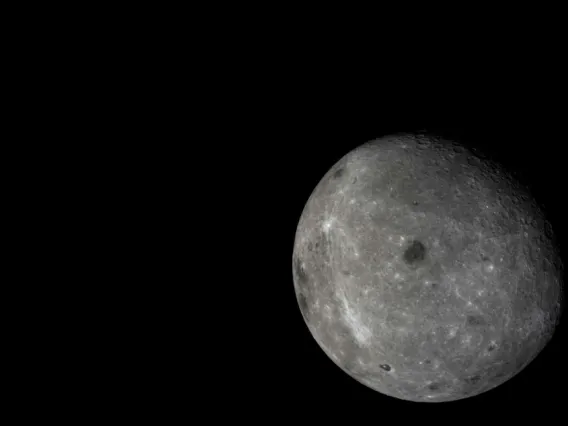
Tracking an Errant Space Rocket to a Mysterious Crater on the Moon
A new study shows how a team at the University of Arizona's Space4 Center tracked down a contested piece of space junk that crashed onto the moon and provides an explanation for why it left not one but two craters.Tracking an Errant Space Rocket to a Mysterious Crater on the Moon
×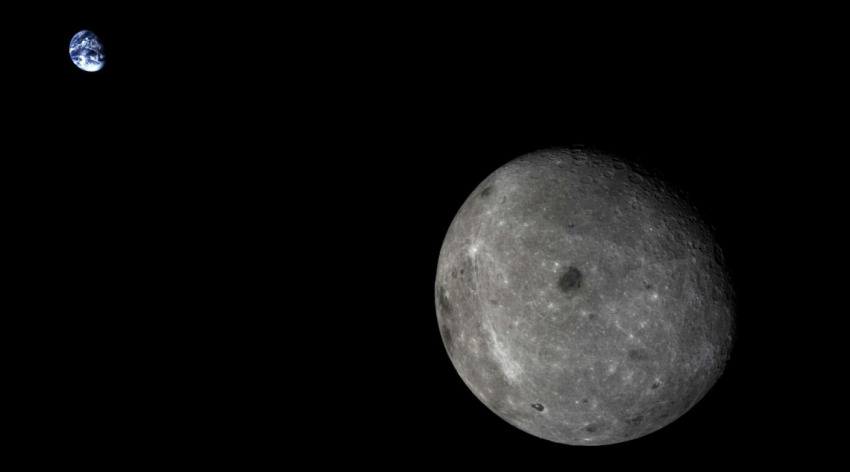
By Daniel Stolte, University Communications - November 16, 2023
In March 2022, a defunct part of a space rocket hurled toward the moon's surface and impacted near the Hertzsprung Crater, an enormous impact feature on the far side of the moon that is never directly visible from Earth. Curiously, and unlike any other space hardware that ended up on the moon's surface, this one left behind not one but two craters, causing speculation about what exactly it was that found its final resting place on the moon's surface, according to Tanner Campbell, a doctoral student at the University of Arizona Department of Aerospace and Mechanical Engineering in the College of Engineering and the study's first author.
In a paper published in the Planetary Science Journal, a team of researchers at UArizona provides the definitive proof that the object was a booster from a Chinese space rocket that had spent several years tumbling through space. The study also found that the abandoned rocket stage likely carried an undisclosed, additional payload.
The moon is no stranger to what one could call high-tech littering – the remains of spacecraft slamming into the moon after they have ended their journeys through space. Several rocket boosters from NASA's Apollo missions are just a few examples of space hardware that future astronauts might stumble on while exploring the cold, quiet and airless lunar landscape.
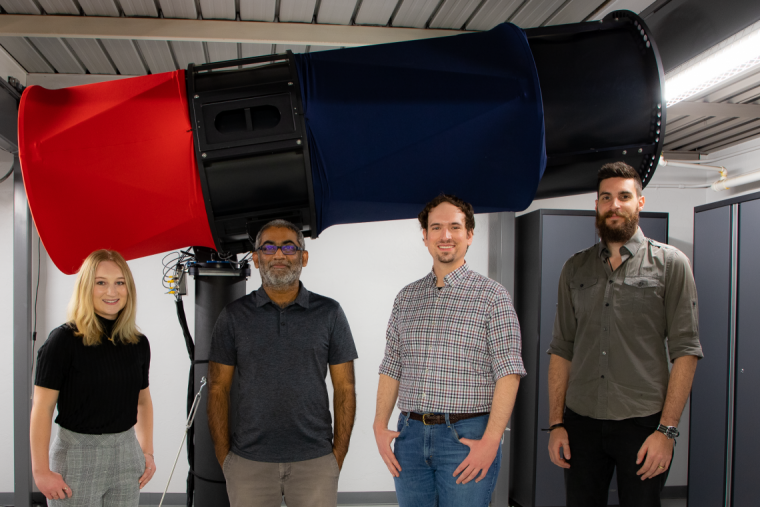
The UArizona Space Domain Awareness team - including Grace Halferty, Vishnu Reddy, Adam Battle and Tanner Campbell, all co-authors on the study - stand in front of the RAPTORS-1 telescope they used for the spectral observations of the errant rocket booster. Vishnu Reddy
Seven years prior, researchers at the UArizona-led Catalina Sky Survey, one of the world's leading programs tasked with detecting and studying asteroids that could pose a hazard to Earth, discovered an object as it moved at a brisk pace between Earth and the moon. They assigned it the designation WE0913A, but its identity was unknown.
Based on its path through the sky, WE0913A was initially thought to be an errant SpaceX Falcon 9 rocket booster from a 2015 launch, with a trajectory that put it on a path to hit the moon. Initial observations with the Raptor Telescope, which was built by the student team, and spectral analysis soon tracked the precise light signals bouncing off the object's surface.
They concluded that WE0913A's light reflection signature and the way it moved through space made it more likely to be a booster from a Chang'e 5-T1, a rocket launched in 2014 as part of the Chinese space agency's lunar exploration program. While the Chinese space agency claimed the rocket booster burned up in Earth's atmosphere upon re-entry, the U.S. Space Command confirmed the rocket's third stage never re-entered the Earth's atmosphere.
Designed as a dry run for a mission to bring a sample of lunar soil back to Earth, the Chang'e 5-T1 was an experimental, robotic spacecraft riding atop of a Long March 3C rocket. The third and uppermost stage of that rocket is the object that was later identified as object WE0913A by the Catalina Sky Survey. The booster provided the thrust that propelled the payloads toward an orbit around the moon. Once spent, it jettisoned the orbiting module and sample return capsule and was then left to its own devices, a typical procedure for rocket boosters after they have fulfilled their duty.
While the rocket booster is too small to be resolved even by a high-powered telescope, the observations yielded a characteristic light curve of brightening and dimming, caused by its rotation.
"As the object is spinning, we see variations in the right light it reflects as the visible surface area is changing," said Vishnu Reddy, a professor of planetary science at the UArizona Lunar and Planetary Laboratory and the director of Space4 Center. Reddy is one of the paper's co-authors and Campbell’s co-adviser. "When the broad side of the rocket is pointed at you, you get more light, and as it turns, you get less light from that side."
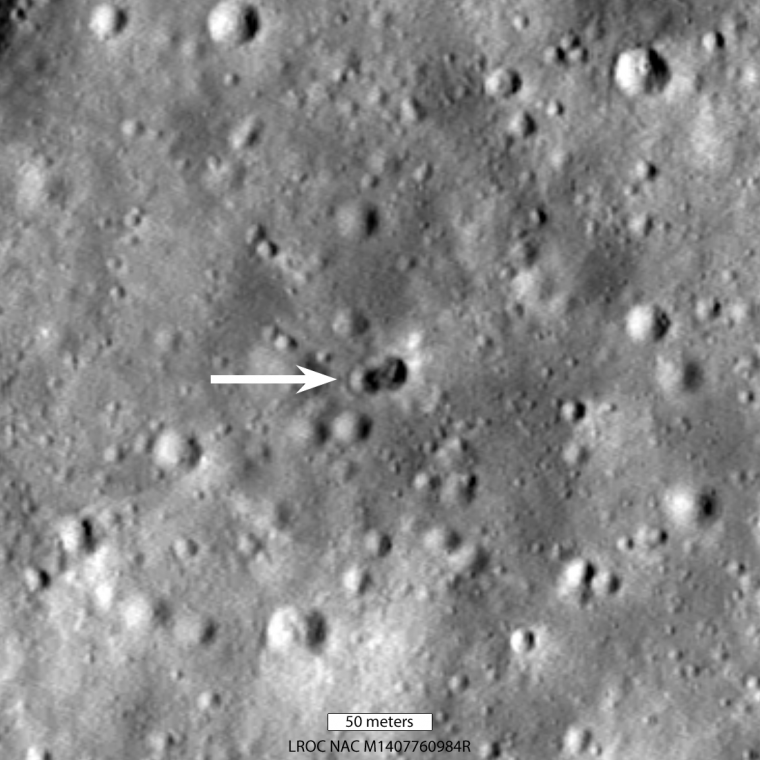
NASA's Lunar Reconnaissance Orbiter took this image of the double crater left by the errant rocket stage when it slammed into the moon's surface near the Hertzsprung crater. The impact site spans roughly 92 feet in the longest dimension. The scale bar equals 164 feet. NASA/GSFC/Arizona State University
By comparing the light curve data with computer simulations of thousands of hypothetical objects floating through space, the team was able to determine that WE0913A was not what would be expected from a rocket booster.
"Something that's been in space as long as this is subjected to forces from the Earth's and the moon's gravity and the light from the sun," Campbell said. "So you would expect it to wobble a little bit, particularly when you consider that the rocket body is a big empty shell with a heavy engine on one side. But this was just tumbling end-over-end, in a very stable way."
In other words, the rocket booster must have had some kind of counterweight to the two engines, each of which weighs 1,200 pounds without fuel.
"We know the booster had an instrument deck mounted to its top end, but those weigh only about 60 pounds or so," Campbell said. "We performed a torque balance analysis, which showed that this amount of weight would have moved the rocket's center of gravity by a few inches – it wasn't nearly enough to account for its stable rotation. That's what leads us to think that there must have been something more mounted to the front."
Further clues came from the impact itself: When the rocket booster slammed into the moon, it made two craters, about 100 feet apart, instead of one. Again, very unusual, according to Campbell, who pointed out that the craters left behind by Apollo rockets are either round, if the impactor came straight down, or oblong, if it came in at a shallow angle.
"This is the first time we see a double crater," he said. "We know that in the case of Chang'e 5 T1, its impact was almost straight down, and to get those two craters of about the same size, you need two roughly equal masses that are apart from each other."
The study illustrates a growing need: Being able to keep track of defunct space hardware after it has served its purpose is vital for the continuation of space exploration. To that end, research programs into what is known as space situational awareness play a critical role, and UArizona's Space4 Center is part of that effort, according to Roberto Furfaro, Space4's deputy director and Campbell's co-adviser.
Furfaro is a co-author of the paper and a professor in the Department of Systems and Industrial Engineering. Other co-authors on the paper from UArizona include Adam Battle, a graduate student at the Lunar and Planetary Lab, and Neil Pearson, Reddy's lab manager.
"There's a big push on both the governmental and commercial level to go to the moon," Furfaro said, "and once you're putting more and more objects on the moon, it becomes extremely important that we not only track the object, but also understand what they are going to do once they get there."
As for the Chang'e 5 T1 rocket's extra payload, there is a good chance that its identity will remain mysterious, Campbell said.
"Obviously, we have no idea what it might have been – perhaps some extra support structure, or additional instrumentation, or something else," he said. "We probably won't ever know."
Tracking an Errant Space Rocket to a Mysterious Crater on the Moon
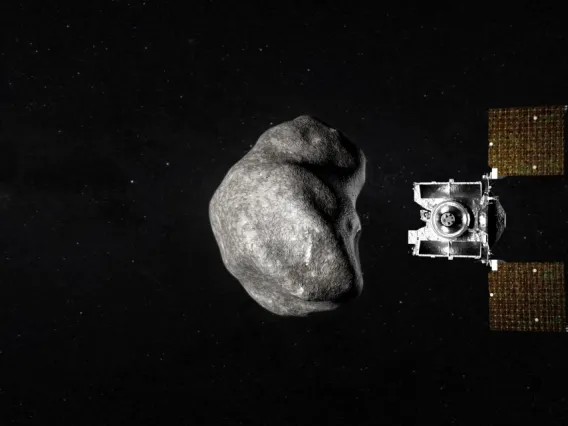
OSIRIS-REx Flies on as OSIRIS-APEX to Explore a Second Asteroid
NASA’s OSIRIS-REx mission learned much about the potentially hazardous asteroid Bennu and its risk to Earth. Now, the mission will change hands and target a different kind of potentially hazardous asteroid, Apophis.OSIRIS-REx Flies on as OSIRIS-APEX to Explore a Second Asteroid
×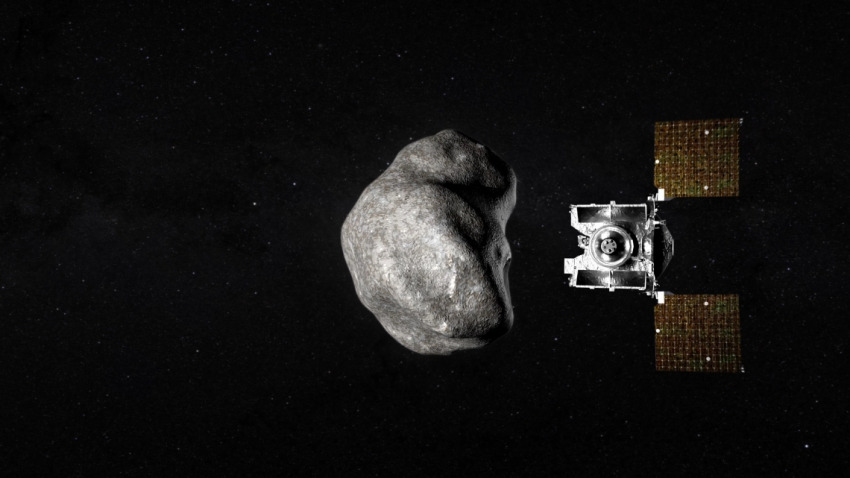
By Mikayla Mace Kelley, University Communications - October 31, 2023
After seven years in space and over 4 billion miles traveled, NASA's OSIRIS-REx mission successfully collected and delivered the first U.S. sample from a near-Earth asteroid. Yet, after all this time and travel, the spacecraft will not retire.
Instead, NASA extended the University of Arizona-led mission so that the spacecraft can be used to study another near-Earth asteroid named Apophis. The mission was renamed OSIRIS-APEX, short for OSIRIS-APophis EXplorer. An overview of the mission was published in the Planetary Science Journal.
 Dani DellaGiustinaChristopher Richards/University Communications
Dani DellaGiustinaChristopher Richards/University Communications
OSIRIS-REx deputy principal investigator Dani DellaGiustina is now the principal investigator for the OSIRIS-APEX mission.
Twenty minutes after dropping the sample high above Earth's atmosphere on Sept. 24, the spacecraft fired its thrusters to put it on course to rendezvous with Apophis in 5½ years – just after Apophis makes its own close approach to Earth. This path includes three Earth gravity assists and several nail-bitingly close laps around the sun.
By April 2, 2029, the spacecraft cameras will begin collecting data as it approaches the asteroid. Apophis will also be closely observed by Earth-based telescopes. But in the hours after the close encounter, Apophis will appear too near the sun in the sky to be observed by Earth-based optical telescopes. This means any changes triggered by the close encounter will be best detected by spacecraft.
The spacecraft will catch up to the asteroid on April 13, 2029, as the asteroid wizzes 20,000 miles above Earth's surface. Scientists will then spend the next 18 months studying the asteroid in detail. They'll also disturb the material on the surface with the spacecraft to reveal what lies just beneath.
"Apophis is an infamous asteroid," said DellaGiustina, who is an assistant professor of planetary sciences at the UArizona Lunar and Planetary Laboratory. "When it was discovered in 2004, there was a scare that it was going to impact the Earth in 2029, but that risk was retired. Then there was another scare that it was going to impact the Earth exactly seven years later, in 2036, but observations combined with modeling now show that Apophis doesn't pose a risk for at least the next one hundred years. Despite this, Apophis still has this role in the psyche of all of us who study these things. While it's not going to impact the Earth in 2029, however, it does get very close."
The 340-meter-wide Apophis is a stony, or S-type, asteroid made of silicate materials and nickel-iron, which are different than C-type asteroids like OSIRIS-REx's first target, Bennu, which are rich in carbonaceous material. Apophis likely formed from a collision of a parent body in the asteroid belt that knocked it toward Earth's neighborhood. The asteroid will pass closer than some of Earth's orbiting satellites and one-tenth the distance to the moon. This is the closest approach by an asteroid of this size in modern history, and it will be visible to the naked eye in the Eastern Hemisphere. An asteroid of this size coming so close to Earth is rare, occurring roughly once every 7,500 years.
The mission considered visiting other targets – even Venus – but Apophis was chosen, because it was the only object that the spacecraft could closely rendezvous with, DellaGiustina said. The close approach allows scientists to study interactions with Earth's gravitational forces, specifically tidal forces that could disturb its surface to reveal what lies beneath.
"Apophis gets close enough that there is some amount of activity that we are anticipating on its surface," DellaGiustina said. "There might be landslides or particle ejections that create a comet-like tail. The close approach is a great natural experiment.
"We know that tidal forces and the accumulation of rubble pile material are foundational processes that could play a role in planet formation. They could inform how we got from debris in the early solar system to full-blown planets. Our best guess right now is that Apophis is, indeed, a rubble pile"
Mission science goals are based on what is known about Apophis from ground-based observations, the team's experiences at Bennu and current data for other S-type asteroids. Ultimately, the team hopes to understand the asteroid's evolution and characteristics, including Apophis' material strength, porosity and density. All they learn can inform planetary defense research, especially because most of the potentially hazardous asteroids are also S-type asteroids like Apophis.
"We learned a lot at Bennu, but now we're armed with even more questions," said Amy Simon, OSIRIS-APEX mission project scientist and senior scientist for Planetary Atmospheres Research in the Solar System Exploration Division at the NASA Goddard Space Flight Center.
For example, as deputy instrument scientist for the OSIRIS-REx Visible and near-IR Spectrometer, Simon and colleagues detected clay minerals and organics on Bennu, suggesting that the asteroid interacted with water in the past. Scientists predicted finding these on C-type asteroids like Bennu but were unable to detect it from ground-based observations.
Simon said she's excited to see how Apophis looks different from expectations and from carbonaceous asteroids Bennu and Ryugu, which Japan visited with the Hayabusa 2 probe in 2018.
Getting up close and personal with these asteroids presents a unique opportunity for planetary scientists. Currently, scientific understanding of solar system formation is heavily informed by meteorites, which are pieces of other celestial bodies that fall to Earth. Asteroids are the primary parent bodies of meteorites but are usually observed from so far away that they appear only as points of light in the sky that reveal little about their global properties or surface variability.
The OSIRIS spacecraft science instruments were specifically designed to connect our understanding of meteorites to their parent asteroids by placing meteorite-scale rocks into geologic context on asteroids and investigating asteroids' geologic processes at Bennu and very soon at Apophis.
OSIRIS-REx Flies on as OSIRIS-APEX to Explore a Second Asteroid
Tracking the Bennu Sample Capsule's Separation from OSIRIS-REx
Data collected ahead of the OSIRIS-REx sample return capsule's plunge into Earth's atmosphere will help test algorithms used to pinpoint asteroids that could impact Earth.Tracking the Bennu Sample Capsule's Separation from OSIRIS-REx
×By Niranjana Rajalakshmi, University Communications - October 25, 2023
Hours before the OSIRIS-REx sample return capsule blasted into Earth’s atmosphere and landed safely in the Utah desert on Sept. 24, a small University of Arizona team was tracking another key part of the mission: the capsule's separation from the spacecraft.
With three optical telescopes at different locations, the team of faculty, students and staff from the Lunar and Planetary Laboratory and the Space4 Center joined industry partners in front of computer screens, watching as one dot – the spacecraft – became two when it released the capsule at around 3:42 a.m. Tucson time.
While tracking the capsule with optical telescopes wasn't officially part of NASA's historic UArizona-led OSIRIS-REx asteroid sample return mission, the event can be used as an analog for tracking an asteroid on a collision course with Earth if one were ever discovered, said Vishnu Reddy, who led the project.
"The techniques used to track an incoming asteroid on its terminal trajectory before it enters the Earth’s atmosphere are the same as us tracking the sample return capsule before it reaches the atmosphere," said Reddy, a planetary sciences professor in the Lunar and Planetary Laboratory and the director of the Space4 Center.
The capsule separation from the spacecraft was visible only between central Australia and the eastern Pacific Ocean. Within that sliver, the team observed the return using three telescopes: two at Siding Spring Observatory in Australia that were operated remotely at the UArizona campus, and one in Kihei, Maui, Hawaii, where researchers observed in person.
After the separation, two telescopes tracked the capsule while one remained on the spacecraft. About 20 minutes after the separation, the spacecraft fired its engines and began its multiyear journey to another asteroid, Apophis. By collecting data on the spacecraft, the team also hopes to better understand how spacecraft maneuver through orbits between the Earth-moon system – information useful for space situational awareness, which is the practice of tracking celestial bodies, understanding their environment and predicting their future positions.
Along with Reddy, the team included graduate students David Cantillo and Adam Battle from the Lunar and Planetary Laboratory and Tanner Campbell from the Department of Aerospace and Mechanical Engineering. Scott Tucker from Starizona, a Tucson-based small business, and Neil Pearson, the lab manager of Reddy's research group, were also part of the group. The team collaborated on the project with scientists supported by the NASA Planetary Defense Coordination Office and the Air Force Research Lab for work relevant to their respective missions.
Tracking at Maui started at 2 a.m. Tucson time, with the spacecraft appearing on the team's computer screens as a blurry dot about 90,000 miles away from the observing location. Successive images of the dot showed it hurtling through space, while the stars in the image remained static.
"We were one of the few research teams that optically tracked the sample return capsule using telescopes just before it entered the atmosphere," Reddy said. "We picked out the object right away and tracked it all the way to the capsule separation, when one object became two."
While the capsule separated from the spacecraft at 3:42 a.m. Tucson time, the UArizona team estimated it would take an additional 20 minutes to see both objects as two individual dots, given the resolution of their telescopes. They were surprised to observe the separation on their computer screens after only eight minutes, at 3:50 a.m. As they collected images, the group processed the data in real time to verify its path.
 Lunar and Planetary Laboratory graduate students Adam Battle (left) and David Cantillo (right) track the OSIRIS-REx spacecraft and sample return capsule remotely using telescopes in Siding Spring, Australia.Space4 Center
Lunar and Planetary Laboratory graduate students Adam Battle (left) and David Cantillo (right) track the OSIRIS-REx spacecraft and sample return capsule remotely using telescopes in Siding Spring, Australia.Space4 Center
"There was a certain feeling of relief, knowing that the sample return capsule had successfully separated from that main spacecraft, and it was on its final journey home," Cantillo said. Cantillo and Battle observed remotely using the telescopes in Australia.
The Maui team continued to track the capsule until 7:38 a.m. Tucson time, a few minutes before it entered the Earth's atmosphere off the coast of California. The capsule traveled at more than 27,000 mph as it descended through Earth's atmosphere.
"This was one of the fastest objects we have ever tracked," Reddy said.
Prior to the Sept. 24 return, Cantillo and Battle developed and tested computer scripts that remotely controlled the telescopes in Australia. To enable tracking, the scripts included precise predicted positions of the spacecraft and capsule the team wanted to track at different times during their five-hour observation block and matched the exact rate at which the spacecraft would be traveling.
What made these observations unique was that the work was mostly front-loaded in terms of planning, and setting up the scripts that were run on telescopes, Cantillo said.
"Fortunately, everything worked flawlessly, and we got all the data we planned for," Battle said.
Tracking the Bennu sample capsule's separation from OSIRIS-REx